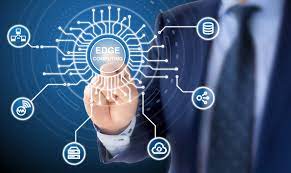What Underlying Concept Is EdgeComputing Based On

Edge computing is founded on the principle of distributed computing, a concept that involves dispersing computing resources among various devices and locations rather than relying solely on a centralized data center. In the context of edge computing, these resources are decentralized to the edge of the network, situated closer to the point where data originates. Distributed computing aims to harness the collective power of multiple devices and diverse locations to process and analyze data concurrently. This approach significantly diminishes latency, enhances response times, and augments overall operational efficiency.
Such advancements are especially crucial in applications necessitating real-time data processing, such as in IoT, autonomous vehicles, and other emerging technologies. Through the dispersion of computing resources at the network’s edge, edge computing facilitates near-real-time data processing and analysis. This capability enables swift extraction of insights and faster decision-making, empowering organizations to refine operations, streamline processes, and foster novel avenues for innovation and progress. In essence, edge computing’s foundation lies in distributed computing, emphasizing the distribution of computing resources across various devices and locations to bolster efficiency and mitigate latency.
What is Edge Computing?
Edge computing represents a distributed approach to computing, positioning computational resources and data storage closer to where they are needed, commonly known as the network’s edge. In this model, local devices or servers perform data processing instead of transferring all information to a centralized data center.
By conducting data processing at the edge, latency is reduced and application reliability is enhanced.
Various architectures support edge computing, encompassing small-scale data centers, edge servers, or devices embedded with specialized edge hardware like sensors or gateways. The implementation of edge computing hinges on the particular use case and the application’s requirements.
History of Edge Computing
The term “edge computing” was coined by Cisco in 2011, denoting computing infrastructure situated closer to the data source, like sensors or mobile devices. Its roots trace back to early computing eras, where mainframe computers handled substantial data processing and storage. As personal computers and the internet emerged, computational power became more dispersed, leading to data processing in globally located data centers. Various factors have propelled the rise of edge computing, including the proliferation of IoT devices, the imperative for real-time or near-real-time data processing, and the expansion of cloud computing. As edge computing advances. Now Edge Computing In Financial Services is anticipated to assume an increasingly pivotal role across diverse industries, spanning healthcare, transportation, and the development of smart cities.
How Edge Computing Works
Edge computing operates by decentralizing computational tasks and data storage, positioning them closer to where they’re needed within a network. Unlike conventional centralized computing, in which facts are transmitted to remote facts facilities for When data is generated by devices like sensors or IoT gadgets, instead of sending the entirety of that information to a centralized data center, edge computing allows for local processing on devices or servers situated at the edge of the network. This proximity enables quicker analysis and decision-making without relying heavily on data transmission over the network.
By leveraging this distributed approach, edge computing significantly reduces latency, or the delay in data processing, leading to faster response times and enhanced efficiency. Moreover, this localized processing contributes to improved reliability, particularly in scenarios requiring real-time data processing, such as in autonomous vehicles, industrial automation, and various IoT applications. when considering the broader implications, How Can Edge Computing Be Used to Improve Sustainability? becomes a pivotal question.
What is the Relationship between Edge Computing and Cloud Computing?
In this hybrid model, edge computing manages data processing at the network’s edge, while cloud computing oversees data storage, management, and processing in the cloud. This amalgamation empowers organizations to optimize their computational resources, decrease expenses, and elevate application performance.
For instance, in an IoT setup, edge computing handles localized data processing, while cloud computing undertakes data storage and analysis over extended periods. This approach allows organizations to analyze data trends and patterns, optimizing system performance. Similarly, in autonomous vehicles, edge computing manages real-time sensor data processing, while cloud computing stores and analyzes data over time.
This analysis aids in identifying driving patterns and areas for enhancement, ultimately improving vehicle safety and performance. In essence, edge and cloud computing are complementary paradigms collaborating within a hybrid model. While edge computing ensures real-time processing and low latency, cloud computing delivers scalability, flexibility, and cost-effectiveness. This integration enables organizations to streamline computing resources and elevate application performance.
What Is Edge Computing Standards
Edge computing standards refer to established guidelines, protocols, and frameworks that define the best practices, interoperability requirements, and specifications for implementing edge computing technologies. These standards aim to ensure consistency, compatibility, and seamless integration among different edge computing solutions and devices. Several organizations developing and promoting standards for edge computing. The Institute of Electrical and Electronics Engineers.
Having standardized practices in edge computing is essential for ensuring compatibility, security, and scalability in diverse environments. As the technology evolves and gains broader adoption the development and adherence to these standards become increasingly crucial to foster an interoperable and efficient edge computing ecosystem.
The Future Outlook For Edge Computing
The future outlook for edge computing appears promising, poised for significant growth and widespread adoption across various industries. The proliferation of Internet of Things devices and the surge in data generation at the network’s edge are driving forces amplifying the relevance and necessity of edge computing solutions.
Its capability to enable real-time data processing, reduce latency, and enhance application performance aligns seamlessly with the escalating demands for swift decision-making and efficient operations. Moreover as the deployment of 5G networks expands, edge computing stands to benefit significantly, leveraging the high-speed, low-latency capabilities of 5G to further enhance its functionality.
This convergence of edge computing and 5G is anticipated to unlock new possibilities, empowering improvements in regions including self reliant vehicles, augmented reality, healthcare, clever cities, and more. Additionally, advancements in edge computing architectures, along with the development of standardized practices and frameworks, will likely contribute to its broader adoption.
Collaborative efforts by industry stakeholders and standardization bodies to address interoperability, security, and scalability concerns will facilitate a more cohesive and accessible edge computing ecosystem.
FAQs
What are the primary advantages of edge computing?
Edge computing offers reduced latency, improved data privacy, enhanced system reliability, and robustness in real-time applications.
How does location computing differ from cloud computing?
Edge computing focuses on decentralized data processing closer to the source, while cloud computing emphasizes centralized processing in remote data centers.
What demanding situations does part computing face?
Edge computing encounters challenges related to security vulnerabilities, scalability, and interoperability, which require robust solutions for effective implementation.
What role does edge computing play in IoT?
Edge computing enhances IoT capabilities by reducing latency, enabling real-time data analysis, and optimizing the functionality of interconnected devices.
How does part computing effect diverse industries?
Edge computing revolutionizes industries by optimizing operations in healthcare, improving customer experience in retail, enhancing financial services, and transforming telecommunications.
What is the destiny outlook for area computing?
The future of edge computing is promising, with advancements in technologies like 5G, AI, and machine learning, offering innovative possibilities and reshaping digital landscapes.
Conclusion
In conclusion, the underlying concept of edge computing revolves around decentralization and proximity. It is rooted in the principle of distributing computational resources closer to where data is generated or utilized, diverging from the traditional centralized model. By bringing computing power nearer to the edge of the network, edge computing endeavors to minimize latency, enhance response times, and optimize data processing efficiency. This concept emphasizes the significance of localized data processing, enabling real-time insights and faster decision-making, particularly crucial in applications like IoT, autonomous systems, and emerging technologies. Ultimately, edge computing’s foundation lies in its ability to harness distributed resources and proximity to the data source, catering to the evolving demands for rapid, efficient, and contextually relevant computing solutions.




